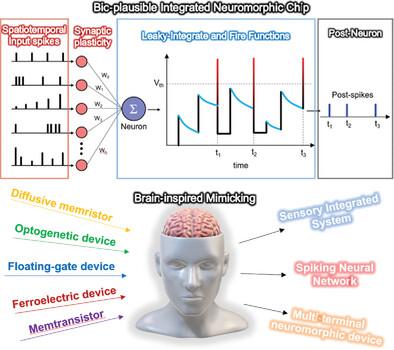当前位置:
X-MOL 学术
›
Adv. Electron. Mater.
›
论文详情
Our official English website, www.x-mol.net, welcomes your feedback! (Note: you will need to create a separate account there.)
Beyond von Neumann Architecture: Brain‐Inspired Artificial Neuromorphic Devices and Integrated Computing
Advanced Electronic Materials ( IF 6.2 ) Pub Date : 2024-04-01 , DOI: 10.1002/aelm.202300839 Hyunho Seok 1 , Dongho Lee 2 , Sihoon Son 1 , Hyunbin Choi 3 , Gunhyoung Kim 3 , Taesung Kim 1, 2
Advanced Electronic Materials ( IF 6.2 ) Pub Date : 2024-04-01 , DOI: 10.1002/aelm.202300839 Hyunho Seok 1 , Dongho Lee 2 , Sihoon Son 1 , Hyunbin Choi 3 , Gunhyoung Kim 3 , Taesung Kim 1, 2
Affiliation

|
Brain‐inspired parallel computing is increasingly considered a solution to overcome memory bottlenecks, driven by the surge in data volume. Extensive research has focused on developing memristor arrays, energy‐efficient computing strategies, and varied operational mechanisms for synaptic devices to enable this. However, to realize truly biologically plausible neuromorphic computing, it is essential to consider temporal and spatial aspects of input signals, particularly for systems based on the leaky integrate‐and‐fire model. This review highlights the significance of neuromorphic computing and outlines the fundamental components of hardware‐based neural networks. Traditionally, neuromorphic computing has relied on two‐terminal devices such as artificial synapses. However, these suffer from significant drawbacks, such as current leakage and the lack of a third terminal for precise synaptic weight adjustment. As alternatives, three‐terminal synaptic devices, including memtransistors, ferroelectric, floating‐gate, and charge‐trapped synaptic devices, as well as optoelectronic options, are explored. For an accurate replication of biological neural networks, it is vital to integrate artificial neurons and synapses, implement neurobiological functions in hardware, and develop sensory neuromorphic computing systems. This study delves into the operational mechanisms of these artificial components and discusses the integration process necessary for realizing biologically plausible neuromorphic computing, paving the way for future brain‐inspired electronic systems.
中文翻译:

超越冯·诺依曼架构:受大脑启发的人工神经形态设备和集成计算
在数据量激增的推动下,类脑并行计算越来越被认为是克服内存瓶颈的解决方案。广泛的研究集中在开发忆阻器阵列、节能计算策略以及突触设备的各种操作机制上,以实现这一目标。然而,为了实现真正生物学上合理的神经拟态计算,必须考虑输入信号的时间和空间方面,特别是对于基于泄漏集成和激发模型的系统。这篇综述强调了神经形态计算的重要性,并概述了基于硬件的神经网络的基本组成部分。传统上,神经形态计算依赖于人工突触等两端设备。然而,这些都存在明显的缺点,例如电流泄漏和缺乏用于精确突触权重调整的第三端子。作为替代方案,我们探索了三端突触器件,包括记忆晶体管、铁电体、浮栅和电荷捕获突触器件以及光电选项。为了准确复制生物神经网络,集成人工神经元和突触、在硬件中实现神经生物学功能以及开发感觉神经形态计算系统至关重要。这项研究深入研究了这些人工组件的运行机制,并讨论了实现生物学上合理的神经拟态计算所需的集成过程,为未来的大脑启发电子系统铺平了道路。
更新日期:2024-04-01
中文翻译:

超越冯·诺依曼架构:受大脑启发的人工神经形态设备和集成计算
在数据量激增的推动下,类脑并行计算越来越被认为是克服内存瓶颈的解决方案。广泛的研究集中在开发忆阻器阵列、节能计算策略以及突触设备的各种操作机制上,以实现这一目标。然而,为了实现真正生物学上合理的神经拟态计算,必须考虑输入信号的时间和空间方面,特别是对于基于泄漏集成和激发模型的系统。这篇综述强调了神经形态计算的重要性,并概述了基于硬件的神经网络的基本组成部分。传统上,神经形态计算依赖于人工突触等两端设备。然而,这些都存在明显的缺点,例如电流泄漏和缺乏用于精确突触权重调整的第三端子。作为替代方案,我们探索了三端突触器件,包括记忆晶体管、铁电体、浮栅和电荷捕获突触器件以及光电选项。为了准确复制生物神经网络,集成人工神经元和突触、在硬件中实现神经生物学功能以及开发感觉神经形态计算系统至关重要。这项研究深入研究了这些人工组件的运行机制,并讨论了实现生物学上合理的神经拟态计算所需的集成过程,为未来的大脑启发电子系统铺平了道路。



























 京公网安备 11010802027423号
京公网安备 11010802027423号